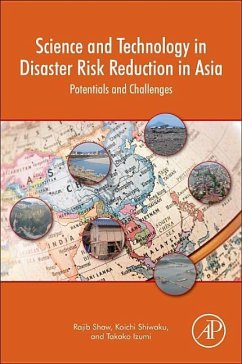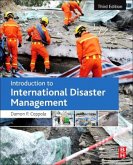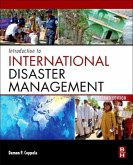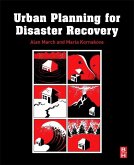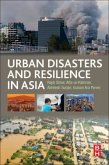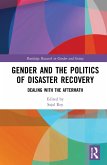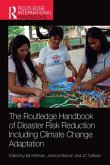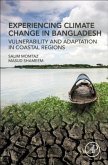Science and Technology in Disaster Risk Reduction in Asia
Potentials and Challenges
Herausgegeben:Shaw, Rajib; Shiwaku, Koichi; Izumi, Takako
Science and Technology in Disaster Risk Reduction in Asia
Potentials and Challenges
Herausgegeben:Shaw, Rajib; Shiwaku, Koichi; Izumi, Takako
- Broschiertes Buch
- Merkliste
- Auf die Merkliste
- Bewerten Bewerten
- Teilen
- Produkt teilen
- Produkterinnerung
- Produkterinnerung
Science and Technology in Disaster Risk Reduction in Asia: Potentials and Challenges provides both a local and global perspective on how to implement the Sendai Framework for Disaster Risk Reduction. Topics demonstrate the advancement of scientific research as it applies to early warning systems, including identifying risk and the strengthening of infrastructure for different types of hazards. Through different major disasters, it has become evident that there must be a balance between hard and soft technology and physical, process and social solutions. This book demonstrates how this has been…mehr
Andere Kunden interessierten sich auch für
![Introduction to International Disaster Management Introduction to International Disaster Management]() Damon CoppolaIntroduction to International Disaster Management84,99 €
Damon CoppolaIntroduction to International Disaster Management84,99 €![Introduction to International Disaster Management Introduction to International Disaster Management]() Damon CoppolaIntroduction to International Disaster Management54,99 €
Damon CoppolaIntroduction to International Disaster Management54,99 €![Urban Planning for Disaster Recovery Urban Planning for Disaster Recovery]() Urban Planning for Disaster Recovery89,99 €
Urban Planning for Disaster Recovery89,99 €![Urban Disasters and Resilience in Asia Urban Disasters and Resilience in Asia]() Rajib ShawUrban Disasters and Resilience in Asia50,99 €
Rajib ShawUrban Disasters and Resilience in Asia50,99 €![Gender and the Politics of Disaster Recovery Gender and the Politics of Disaster Recovery]() Gender and the Politics of Disaster Recovery154,99 €
Gender and the Politics of Disaster Recovery154,99 €![The Routledge Handbook of Disaster Risk Reduction Including Climate Change Adaptation The Routledge Handbook of Disaster Risk Reduction Including Climate Change Adaptation]() The Routledge Handbook of Disaster Risk Reduction Including Climate Change Adaptation49,99 €
The Routledge Handbook of Disaster Risk Reduction Including Climate Change Adaptation49,99 €![Experiencing Climate Change in Bangladesh Experiencing Climate Change in Bangladesh]() Salim MomtazExperiencing Climate Change in Bangladesh62,99 €
Salim MomtazExperiencing Climate Change in Bangladesh62,99 €-
-
-
Science and Technology in Disaster Risk Reduction in Asia: Potentials and Challenges provides both a local and global perspective on how to implement the Sendai Framework for Disaster Risk Reduction. Topics demonstrate the advancement of scientific research as it applies to early warning systems, including identifying risk and the strengthening of infrastructure for different types of hazards. Through different major disasters, it has become evident that there must be a balance between hard and soft technology and physical, process and social solutions. This book demonstrates how this has been successfully implemented in Asia, and how these applications can apply on a global basis.
Produktdetails
- Produktdetails
- Verlag: Academic Press / Elsevier Science & Technology
- Artikelnr. des Verlages: C2016-0-01555-3
- Seitenzahl: 524
- Erscheinungstermin: 3. Oktober 2017
- Englisch
- Abmessung: 154mm x 229mm x 33mm
- Gewicht: 840g
- ISBN-13: 9780128127117
- ISBN-10: 0128127112
- Artikelnr.: 48096302
- Herstellerkennzeichnung
- Libri GmbH
- Europaallee 1
- 36244 Bad Hersfeld
- gpsr@libri.de
- Verlag: Academic Press / Elsevier Science & Technology
- Artikelnr. des Verlages: C2016-0-01555-3
- Seitenzahl: 524
- Erscheinungstermin: 3. Oktober 2017
- Englisch
- Abmessung: 154mm x 229mm x 33mm
- Gewicht: 840g
- ISBN-13: 9780128127117
- ISBN-10: 0128127112
- Artikelnr.: 48096302
- Herstellerkennzeichnung
- Libri GmbH
- Europaallee 1
- 36244 Bad Hersfeld
- gpsr@libri.de
Koichi Shiwaku is a Researcher in the Graduate School of Global Environmental Studies of Kyoto University, Japan. He has been working with central and local governments, NGOs, school teachers and students, and local communities in Japan and overseas countries. His recent works are enhancing school disaster resilience and capacity development of officers of board of education in the area affected by the 2011 Great East Japan Earthquake. His research interests are disaster education, community based disaster risk management, governance for disaster education, school safety, and capacity development of local government.
1. Science and Technology in Disaster Risk Reduction: An Analytical Overview
Part 1: Understanding disaster risk
2. Understanding Disaster Risk and Science and Technology
3. Social Background in Char Areas, Bangladesh: Implication for Japanese Hazard Mapping Technology
4. Validation of indigenous knowledge for disaster resilience against river flooding and bank erosion
5. Hazard development chain of climate change induced salinity intrusion in Sundarbans socio-ecological system, Bangladesh
Part 2: Strengthening disaster risk governance to manage disaster risk
6. Disaster Risk Governance and City Resilience in Asia-Pacific region
7. Strengthening disaster risk governance to manage disaster risk: An overview
8. Education Governance and the Role of Science and Technology
9. Utilizing Ecosystem Services for Disaster Risk Reduction: The Role of Scale and Context
10. Building Code Implementation in Nepal: An Experience on Institutionalizing Disaster Risk Reduction in Local Governance System
11. Disaster Risk Governance in Myanmar: problems and constraints
Part 3: Investing in disaster risk reduction for resilience
12. Investing in Disaster risk reduction and implication to utilization of Science and Technology
13. Role of Small and Medium Scale Enterprises in Urban Resilience of Mumbai
14 Constraints in institutional investment on DRR in India
15 Post Disaster Needs Assessment for Resilient Recovery using Innovative Tools, Techniques and Space Applications
16. Community-based Responses to Flood and River Erosion Hazards in the Active Ganges Floodplain of Bangladesh
Part 4: Enhancing disaster preparedness for effective response and to "Build Back Better" in recovery, rehabilitation and reconstruction
17. Recovery process and Science and Technology: an Overview
18. Capacity Development of School Teachers in Disaster Recovery Process
19. Role of Social Transformation in Community Recovery from Cyclone Nargis: Case of Kung Thee Chaung Village, Myanmar
20. Built Back Better: Focus on Resilience and Participation-A Case of Sikkim Reconstruction and Rehabilitation
21. Improvement of Responses and Recovery Approaches for Cyclone Hazards in Bangladesh
22. Constraints and coping measures of coastal community towards safe drinking water scarcity in southwestern Bangladesh
Part 1: Understanding disaster risk
2. Understanding Disaster Risk and Science and Technology
3. Social Background in Char Areas, Bangladesh: Implication for Japanese Hazard Mapping Technology
4. Validation of indigenous knowledge for disaster resilience against river flooding and bank erosion
5. Hazard development chain of climate change induced salinity intrusion in Sundarbans socio-ecological system, Bangladesh
Part 2: Strengthening disaster risk governance to manage disaster risk
6. Disaster Risk Governance and City Resilience in Asia-Pacific region
7. Strengthening disaster risk governance to manage disaster risk: An overview
8. Education Governance and the Role of Science and Technology
9. Utilizing Ecosystem Services for Disaster Risk Reduction: The Role of Scale and Context
10. Building Code Implementation in Nepal: An Experience on Institutionalizing Disaster Risk Reduction in Local Governance System
11. Disaster Risk Governance in Myanmar: problems and constraints
Part 3: Investing in disaster risk reduction for resilience
12. Investing in Disaster risk reduction and implication to utilization of Science and Technology
13. Role of Small and Medium Scale Enterprises in Urban Resilience of Mumbai
14 Constraints in institutional investment on DRR in India
15 Post Disaster Needs Assessment for Resilient Recovery using Innovative Tools, Techniques and Space Applications
16. Community-based Responses to Flood and River Erosion Hazards in the Active Ganges Floodplain of Bangladesh
Part 4: Enhancing disaster preparedness for effective response and to "Build Back Better" in recovery, rehabilitation and reconstruction
17. Recovery process and Science and Technology: an Overview
18. Capacity Development of School Teachers in Disaster Recovery Process
19. Role of Social Transformation in Community Recovery from Cyclone Nargis: Case of Kung Thee Chaung Village, Myanmar
20. Built Back Better: Focus on Resilience and Participation-A Case of Sikkim Reconstruction and Rehabilitation
21. Improvement of Responses and Recovery Approaches for Cyclone Hazards in Bangladesh
22. Constraints and coping measures of coastal community towards safe drinking water scarcity in southwestern Bangladesh
1. Science and Technology in Disaster Risk Reduction: An Analytical Overview
Part 1: Understanding disaster risk
2. Understanding Disaster Risk and Science and Technology
3. Social Background in Char Areas, Bangladesh: Implication for Japanese Hazard Mapping Technology
4. Validation of indigenous knowledge for disaster resilience against river flooding and bank erosion
5. Hazard development chain of climate change induced salinity intrusion in Sundarbans socio-ecological system, Bangladesh
Part 2: Strengthening disaster risk governance to manage disaster risk
6. Disaster Risk Governance and City Resilience in Asia-Pacific region
7. Strengthening disaster risk governance to manage disaster risk: An overview
8. Education Governance and the Role of Science and Technology
9. Utilizing Ecosystem Services for Disaster Risk Reduction: The Role of Scale and Context
10. Building Code Implementation in Nepal: An Experience on Institutionalizing Disaster Risk Reduction in Local Governance System
11. Disaster Risk Governance in Myanmar: problems and constraints
Part 3: Investing in disaster risk reduction for resilience
12. Investing in Disaster risk reduction and implication to utilization of Science and Technology
13. Role of Small and Medium Scale Enterprises in Urban Resilience of Mumbai
14 Constraints in institutional investment on DRR in India
15 Post Disaster Needs Assessment for Resilient Recovery using Innovative Tools, Techniques and Space Applications
16. Community-based Responses to Flood and River Erosion Hazards in the Active Ganges Floodplain of Bangladesh
Part 4: Enhancing disaster preparedness for effective response and to "Build Back Better" in recovery, rehabilitation and reconstruction
17. Recovery process and Science and Technology: an Overview
18. Capacity Development of School Teachers in Disaster Recovery Process
19. Role of Social Transformation in Community Recovery from Cyclone Nargis: Case of Kung Thee Chaung Village, Myanmar
20. Built Back Better: Focus on Resilience and Participation-A Case of Sikkim Reconstruction and Rehabilitation
21. Improvement of Responses and Recovery Approaches for Cyclone Hazards in Bangladesh
22. Constraints and coping measures of coastal community towards safe drinking water scarcity in southwestern Bangladesh
Part 1: Understanding disaster risk
2. Understanding Disaster Risk and Science and Technology
3. Social Background in Char Areas, Bangladesh: Implication for Japanese Hazard Mapping Technology
4. Validation of indigenous knowledge for disaster resilience against river flooding and bank erosion
5. Hazard development chain of climate change induced salinity intrusion in Sundarbans socio-ecological system, Bangladesh
Part 2: Strengthening disaster risk governance to manage disaster risk
6. Disaster Risk Governance and City Resilience in Asia-Pacific region
7. Strengthening disaster risk governance to manage disaster risk: An overview
8. Education Governance and the Role of Science and Technology
9. Utilizing Ecosystem Services for Disaster Risk Reduction: The Role of Scale and Context
10. Building Code Implementation in Nepal: An Experience on Institutionalizing Disaster Risk Reduction in Local Governance System
11. Disaster Risk Governance in Myanmar: problems and constraints
Part 3: Investing in disaster risk reduction for resilience
12. Investing in Disaster risk reduction and implication to utilization of Science and Technology
13. Role of Small and Medium Scale Enterprises in Urban Resilience of Mumbai
14 Constraints in institutional investment on DRR in India
15 Post Disaster Needs Assessment for Resilient Recovery using Innovative Tools, Techniques and Space Applications
16. Community-based Responses to Flood and River Erosion Hazards in the Active Ganges Floodplain of Bangladesh
Part 4: Enhancing disaster preparedness for effective response and to "Build Back Better" in recovery, rehabilitation and reconstruction
17. Recovery process and Science and Technology: an Overview
18. Capacity Development of School Teachers in Disaster Recovery Process
19. Role of Social Transformation in Community Recovery from Cyclone Nargis: Case of Kung Thee Chaung Village, Myanmar
20. Built Back Better: Focus on Resilience and Participation-A Case of Sikkim Reconstruction and Rehabilitation
21. Improvement of Responses and Recovery Approaches for Cyclone Hazards in Bangladesh
22. Constraints and coping measures of coastal community towards safe drinking water scarcity in southwestern Bangladesh

